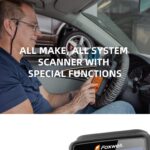The OBD2 port in your vehicle is a gateway to a wealth of diagnostic information. Many car owners and mechanics use OBD2 scanners and devices to monitor performance, diagnose issues, or even customize vehicle settings. With the increasing popularity of these tools, you might wonder if you can use an Obd2 3 Way Splitter to connect multiple devices at once. While the idea of simultaneously using a scan tool, a performance monitor, and a telematics device sounds convenient, it’s crucial to understand the potential problems involved.
The CAN Bus Communication Conflict
Modern vehicles use a Controller Area Network (CAN) bus system for communication between various electronic control units (ECUs), including the Powertrain Control Module (PCM). OBD2 scan tools communicate with the PCM through this CAN bus. The issue arises when you attempt to run multiple scan devices simultaneously using an obd2 3 way splitter.
Each OBD2 scan device, or tool, typically uses a specific node ID to request data from the PCM. When you have multiple devices connected and actively requesting data at the same time, the PCM processes these requests in the order received. However, the problem emerges when the PCM sends the requested data back.
Because all connected devices are listening on the CAN bus for responses, they all might receive the data transmitted by the PCM. The crucial point is that only one device is actually intended to receive and correctly interpret that specific data packet. This overlap can lead to several undesirable outcomes.
Data Misinterpretation and Device Freeze-Ups
When multiple devices receive data intended for only one, it can cause miscommunication. One or more of the devices might display incorrect data readings, leading to false diagnoses or misleading performance information. In more severe cases, this data collision and misinterpretation can even cause one or more of your OBD2 devices to freeze or malfunction, requiring a restart or disconnection.
The Specific Scenario: Separate ECM and TCM
There’s a very specific situation where running two OBD2 devices might avoid conflict, but it’s highly dependent on your vehicle’s architecture. If your vehicle has separate Engine Control Modules (ECM) and Transmission Control Modules (TCM) that operate on distinct CAN Node IDs – for example, some older models with separate modules like the 6.0L, 6.4L, or 6.7L engines – then you might be able to monitor transmission data with one device and engine data with another without immediate conflict. In such cases, the ECM and TCM might use different CAN Node IDs (like 0x7E0 for ECM and 0x7E1 for TCM), potentially preventing data intended for one module from being misinterpreted by a device monitoring the other.
However, even in this specific scenario, success isn’t guaranteed, and it doesn’t apply to most modern vehicles with integrated ECUs. Furthermore, introducing an obd2 3 way splitter and multiple devices can potentially introduce other communication issues and is generally not recommended for reliable operation.
Bus Termination and Other Potential Problems
Beyond the data request conflicts, using an obd2 3 way splitter and multiple devices can also introduce problems related to CAN bus termination. Proper bus termination is essential for signal integrity on the CAN bus. Adding multiple devices in a parallel configuration via a splitter might disrupt the intended bus termination, potentially leading to communication errors and instability within your vehicle’s network.
While bus termination issues are “another story” as mentioned in the original text, they represent another layer of potential problems when deviating from the standard single-device OBD2 connection.
Conclusion: Proceed with Caution
In conclusion, while obd2 3 way splitters are available, using them to run multiple OBD2 devices simultaneously is generally not advisable. The potential for data conflicts, device malfunction, and communication issues outweighs the convenience of having multiple devices connected at once. Unless you have a very specific and well-understood use case, like monitoring separate ECM and TCM data on older vehicles (and even then with caution), it’s best to avoid using splitters for simultaneous operation. If you need to use multiple OBD2 devices, it’s generally recommended to use them one at a time to ensure reliable and accurate data and avoid potential conflicts on your vehicle’s CAN bus system.
